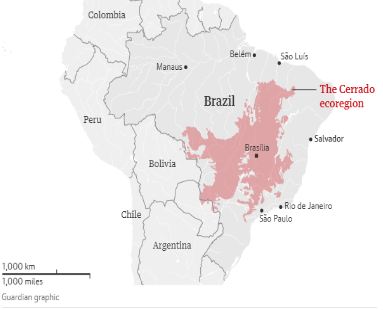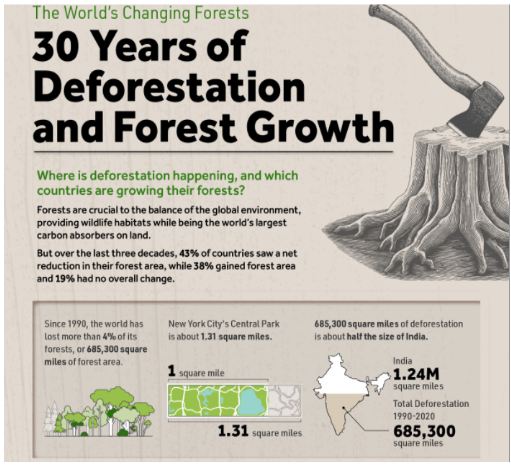Brazil: deforestation jumps in world’s largest savanna as scientists raise alarm
- Posted By
10Pointer
- Categories
Environment
- Published
10th Jan, 2022
-
-
Context
Deforestation last year rose to the highest level since 2015 in Brazil’s Cerrado, prompting scientists to raise alarm over the state of the world’s most species-rich savanna and a major carbon sink that helps to stave off climate change.
-
Background
- In 2010, the world had 3.92 Global Hectare (Gha) of tree cover, extending over 30 per cent of its land area. In 2020, it lost 25.8 Mha of tree cover.
- Nearly 31% of the Earth’s total land area currently constitutes forests, that spans over 15.68 million square miles (40.6 million km²).
- But in last thirty years, more than 4% (685,300 square miles) of it has been lost that is equal to half the size of India.
-
Analysis
What is Deforestation?
- Deforestation refers to the cutting, clearing, and removal of rainforest or related ecosystems into less bio-diverse ecosystems such as pasture, cropland, or plantations.
- Major reasons of deforestation include:
- Changing weather pattern
- Logging
- Mining
- Oil and gas extraction
- Cattle ranching
- Agriculture: Cash crops
- Local, National, and International factors: development, land titles, civil wars, debt, lack of resources, and lack of law enforcement
-
What are the consequences of deforestation?
- Loss of biodiversity, extinction (microbes (bacteria), plants, insects, animals, indigenous peoples, etc.)
- Habitat fragmentation: This can further lead to many problems such as territorial conflicts, homelessness (loss of habitat), lack of food availability, migration disturbances, etc.
- Degradation: It leads to soil erosion and loss of ecosystem.
- Changes in watershed geomorphology
- Desertification (dry, hot, arid conditions)
- Climate change: Deforestation simply lead to release of more carbon dioxide into the atmosphere, thus increasing the effects of global warming.
- Pollution (ground, water and air pollution)
- Displacement of people (loss of farmland, forest resources, etc).
- Loss of culture
- Social conflicts and struggles over land and natural resources.
- Conflicts over racial and ethnic rights.
- Poisoning from oil and mining waste.
- Economic uncertainty
-
What is Brazil’s Cerrado?
- The Cerrado is the world’s largest savanna spread across several states of Brazil.
- It is a vast, tropical savannah stretching diagonally up through the middle of Brazil that covers 2 million sq km, around 22% of the country, as well as parts of Bolivia and Paraguay.
- The biodiversity-rich Cerrado has 11,620 plant, 1,200 fish and 837 fish species and its 200 mammals include jaguars, anteaters, rhea birds and tapirs.
- It is often called an “upside-down forest” because of the deep roots its plants sink into the ground to survive seasonal droughts and fires.

|
Savannas
- Savannas are a transitional biome, not really a forest and not really a desert – just somewhere in between.
- This habitat is home to many different species of plants and animals around the world.
- The savanna biome, which is a type of grassland biome, consists of areas of open grassland with very few trees. There are two kinds of savannas:
- Tropical Savannas
- Semi-tropical Savannas
|
-
How is the region’s landscape changing?
- Over half of its landscape – grassland scrub and dry forest – has been converted to agriculture as it produces soya for China, Europe and other markets.
- The region lost 105,000 square kilometres of native cover from 2008-2018, i.e., 50% more than the Amazon, which has more legal protection.
-
Deforestation in India
- India reported about 0.38 per cent of annual growth in forest, and saw an increase of about 4,000sq km of forest between 2017 and 2019.
- However, the Covid-19 pandemic lockdown has impacted about 0.67 per cent of global forests, according to the Global Forest Watch Report.
- During this period, India lost about 38,500ha of tropical forest in 2019-2020.
- At present, 24.56 per cent of the geographical land is under forest cover. Still, India is unlikely to reach its goal to cover up to 33 per cent of land under forest cover.

|
India pledged to cut its carbon emissions to net zero by 2070 at the 2021 Conference of Parties (COP) 26 in Glasgow.
|
-
Conclusion
Deforestation to make way for economic development is a trade-off that the world cannot afford in the wake of the current climate crisis. Forest conservation needs to be prioritised above short-term economic gains from diamond mines, development projects and tiger safaris.

